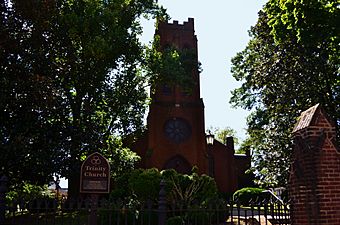Trinity Episcopal Church (Staunton, Virginia) facts for kids
|
Trinity Episcopal Church
|
|
|
U.S. Historic district
Contributing property |
|

Trinity Episcopal Church
|
|
| Location | 214 West Beverley Street, Staunton, Virginia |
|---|---|
| Area | 9.9 acres (4.0 ha) |
| Built | 1855 |
| Architect | Taylor, Edwin M. |
| Architectural style | Gothic Revival |
| NRHP reference No. | 72001532 |
Quick facts for kids Significant dates |
|
| Added to NRHP | May 5, 1972 |
The Trinity Episcopal Church in Staunton, Virginia, is a beautiful old church built in the Gothic Revival style. It's an active church that belongs to the Episcopal Church. This special building was added to the National Register of Historic Places (NRHP) in 1972, which means it's an important historical site. You can find it in the Newtown Historic District of Staunton.
Contents
History of Trinity Episcopal Church
The Trinity Episcopal Church has a long and interesting history. It started as Augusta Parish Church in 1746. This makes it the oldest church in Staunton. The first leader, called a rector, was Reverend John Hindman in 1747.
For many years, Augusta Parish Church was very important. It even served as the local government for Augusta County until 1780. In 1781, something very important happened here. The Virginia General Assembly, which is like the state's government, had to leave Monticello because British troops were coming. They met in Augusta Parish Church from June 7 to June 23, 1781.
The building you see today is actually the third church built on this spot.
The Church Building
The first church building on this site was finished in 1763. The current church was designed by an English architect named James Wood Johns. It was built between 1852 and 1855. The style is called Early Gothic Revival.
Over the years, the church has been changed and updated many times. For example, the aisles were made wider between 1869 and 1872. The chancel, which is the area near the altar, was made longer in 1887. The inside of the church was also updated several times, including in 1907, 1936, 1955, and 2000.
In 1957, the interior was rebuilt again to make space for a very large, 20-ton organ. More big renovations happened between 1999 and 2000. During this time, air conditioning and new electrical systems were added. The beautiful stained glass windows were cleaned and repaired. A new organ was also installed in 2000. In 2010, an outdoor brick labyrinth was added, which is a special path for walking and quiet thinking.
Amazing Stained-Glass Windows
Trinity Church is famous for its amazing stained-glass windows. They are like artistic treasures! There are five main styles of glass in the church, showing how art changed over time.
- Oldest Windows: Some windows date back to the 1850s. These are simple, with diamond-shaped pieces of glass. They have soft white and pale brown colors. The borders are bright blue, green, and yellow glass with black patterns.
- Arts and Crafts Style: Later windows show the Arts and Crafts Movement. This was a special American way of making glass. Around 1825, companies learned to press molten glass into shapes like "jewels" and flowers. These windows have bright colors and faceted glass. Examples include the Passion Window, the Trinity Window (around 1872-80), and the Narcissus Window (around 1887).
- Symbolic Windows: Another style shows Christian symbols against colored glass. The Geometrical Window, made in the mid-1870s, is a great example. It has eight round designs set against red and blue glass.
- Opalescent Windows (Tiffany): Around the early 1900s, a new type of glass called "opalescent" became popular. This was another American invention. Famous artists like Louis Comfort Tiffany used this glass. Trinity Church has thirteen opalescent windows, and twelve of them are by Tiffany! These windows were made between 1898 and 1936. They show many different subjects and how Tiffany's style changed. The oldest and perhaps most beautiful Tiffany window is The Ascension (1899), which is above the altar. Other Tiffany windows include Angel with a Script, St. Luke, Easter Morn, The Good Samaritan, Faith (Angel), Madonna, St. Michael the Archangel, and the Benedicite Window.
- Neo-Gothic Style: After World War II, churches started to prefer windows that looked like old medieval European ones. These windows use small pieces of mouth-blown glass and have figures and symbols. They often use bright primary colors. The Wise Men Window (1946) is an example of this style, with deeper colors and sharper lines.
From 1948 to 1970, an English company called Wippell designed nine more windows for Trinity Church. These windows also look like English Gothic windows, with bright primary colors. They include the Communion and Missionary Windows, The Sermon on the Mount, the Jewels Triptych, Archbishop Crammer, and the diocesan shields.
Life at Trinity Church Today
The current leader of Trinity Episcopal Church is the Reverend William A. J. Heine, who is called "AJ." He started at the church in 2021. According to the church's website, Father AJ loves "Growing community, crossing borders, building bridges, and connecting people to the love of God in Jesús Christ."
The church also has a deacon named the Reverend Shirley E. Ruedy.
The church office is open from Monday to Friday, 9:00 am to 5:00 pm. During the summer, the office closes a bit earlier on Fridays, at 12:00 noon.



